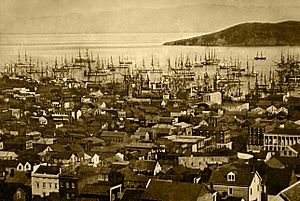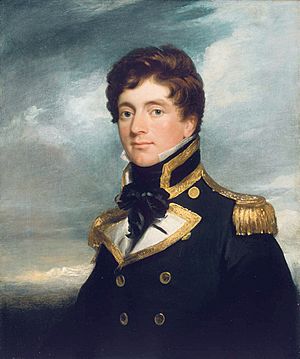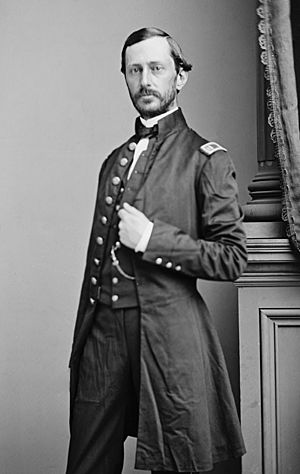Blossom Rock (San Francisco Bay) facts for kids
Blossom Rock was a hidden danger for ships sailing into or out of San Francisco Bay in the 1800s. It was a large rock that sat just below the water's surface. This made it very hard for ship captains to see.
In 1827, a British naval officer named Captain F. Beechey found the rock. He was exploring the bay in his ship, the HMS Blossom. The rock was named "Blossom Rock" after his ship. It was located between Alcatraz Island and Yerba Buena Island.
Captain Beechey noticed two very tall redwood trees on the east side of the bay. He realized sailors could use these "Navigation Trees" to figure out where the rock was. This helped ships avoid hitting it. However, these important trees were cut down in the early 1850s. After that, it became much harder to avoid Blossom Rock. People tried to mark the rock with buoys, but the strong bay currents always swept them away.
Finally, in 1870, a team of US military engineers decided to remove the rock. They wanted to make the bay safe for ships.
Contents
Discovering the Hidden Rock
In 1827, Captain Frederick William Beechey of the Royal Navy was mapping San Francisco Bay. He was sailing between the Golden Gate and the main port. That's when he found a large, hidden rock. It was about 1,000 yards (914 meters) from the port.
Captain Beechey realized the rock was too big to move with the tools they had back then. So, he named it "Blossom Rock" after his ship. This rock was a big problem because it was usually about 5 feet (1.5 meters) underwater. This meant ships couldn't see it and could easily crash into it.
Long ago, the eastern side of San Francisco Bay had huge forests of giant redwood trees. These trees were still there in the 1840s.
Captain Beechey noticed that two redwood trees on the hills stood out from the others. He figured out that sailors could use these two trees as landmarks. By lining them up, they could tell exactly where Blossom Rock was. These trees became known as the "Navigation Trees." They were very important for keeping ships safe.
Today, there's a special marker, California Historical Landmark #962, at the spot where these trees once stood.
Sadly, many of the old redwood forests were cut down starting around 1840. By 1860, almost all of them were gone. The Navigation Trees themselves were cut down between 1851 and 1854. This meant sailors lost their easy way to avoid Blossom Rock.
The US Navy tried to put buoys around the rock many times. But the strong currents in the bay always washed them away. Because the rock was such a big danger, the US Army Corps of Engineers was given the job to remove it.
Removing Blossom Rock
In 1866, Colonel Robert Williamson of the US Army Corps of Engineers decided to blast the rock. He wanted to make it safe for ships to pass over. He asked Edward Cordell, a surveyor, to measure the water depth before and after each blast.
Early Blasting Attempts
In January 1867, Cordell and his team started their work. On January 30, the first blast was set off. But it didn't make any difference to the rock's depth. They tried again the next morning, with the same result.
They continued blasting throughout February. Cordell's crew would measure the depth after each explosion. But after seven blasts, there was still no change in the water depth over the rock. Cordell stopped his work for a while.
However, Colonel Williamson asked him to continue. They tried more blasts in March. In total, they blasted the rock a dozen times. But the results were not very good. They ran out of explosives and had to stop. The rock was still a danger.
New Plans for Removal
In 1870, Major R. S. Williamson and Lieutenant W. H. Heuer took over the project. Their first step was to measure the rock accurately. No one had been able to do this properly before. They found that the top of the rock was 5 feet (1.5 meters) below the water at low tide. At a depth of 24 feet (7.3 meters), the rock was 125 feet (38 meters) long and 105 feet (32 meters) wide. Their goal was to clear the channel to a depth of 24 feet (7.3 meters).
Testing Explosives on the Surface
The team prepared three gunpowder charges: 75, 125, and 175 pounds (34, 57, and 79 kg). They sealed each charge in a waterproof wooden barrel. They added heavy iron pieces to the barrels to keep them from floating away.
They did several tests:
- On January 29, a 75-pound charge exploded under 16 feet (4.9 meters) of water. The rock "shattered," but no big pieces broke off.
- The next day, a 175-pound charge exploded under 11 feet (3.4 meters) of water. A diver went down to check. He found cracks but no increase in depth.
- On February 9, another 175-pound charge exploded under 14 feet (4.3 meters) of water. This blast sent water 40 feet (12 meters) into the air! It removed about 11 cubic yards (8.4 cubic meters) of rock.
- More tests followed, using different charge sizes and water depths. Some removed more rock than others. They learned that larger charges and more water above the charge helped remove more rock.
What They Learned
From these tests, Williamson and Heuer learned important things:
- Larger explosive charges worked better than smaller ones.
- The more water there was above the charge, the more effective the explosion was.
- They thought a metal container for the explosives would work better than a wooden one.
These findings led them to believe that drilling into the rock first, then placing the explosive deep inside, would be the best way to remove it.
Blossom Rock is Gone!
After Williamson and his team finished their work, Blossom Rock was cleared to a depth of 21 feet (6.4 meters) below low tide. But the work wasn't completely done.
By December 27, 1903, the rock was further removed to a depth of 30 feet (9.1 meters). This made the bay even safer for ships.
Finally, in 1974, the US Army Corps of Engineers reported that Blossom Rock and other dangerous rocks in San Francisco Bay had been removed to a depth of 40 feet (12.2 meters). This was part of a bigger project to make the shipping channels wider and deeper for modern ships. Now, ships can pass safely over where Blossom Rock once was.
Images for kids







